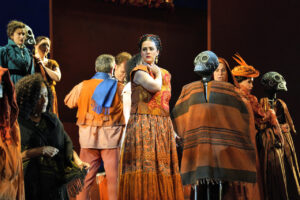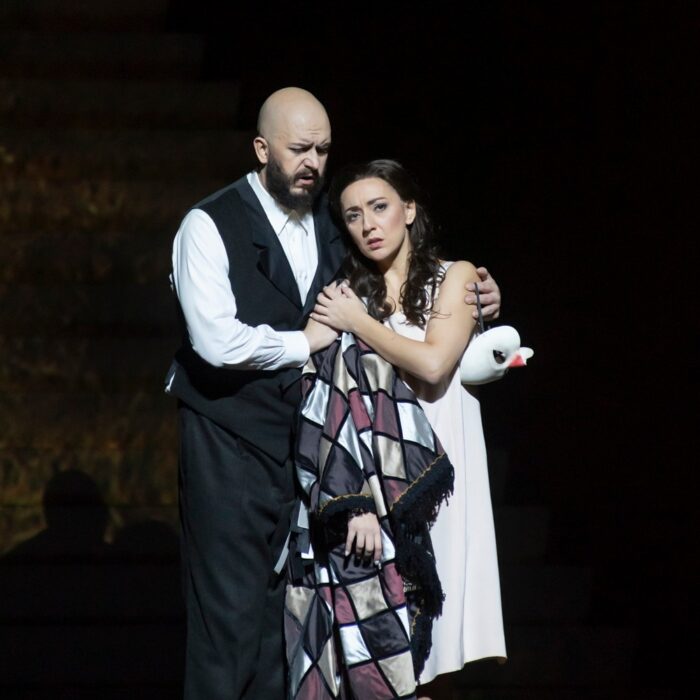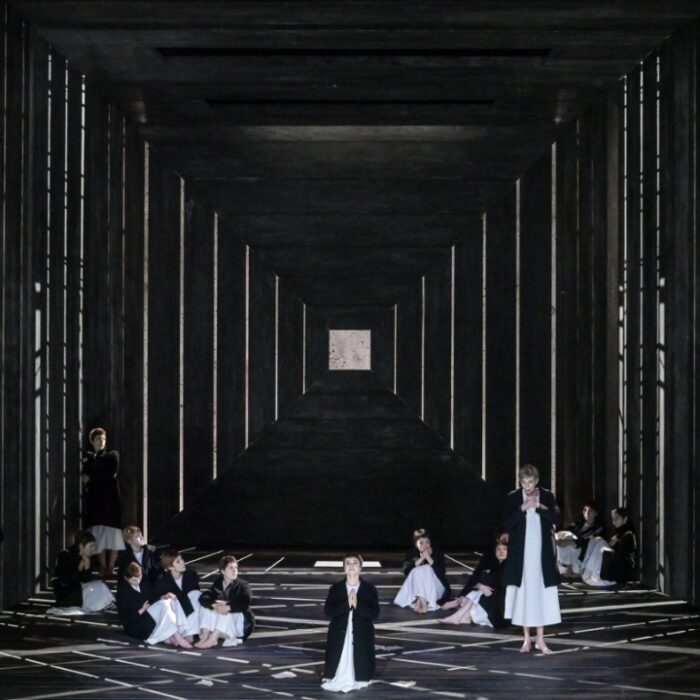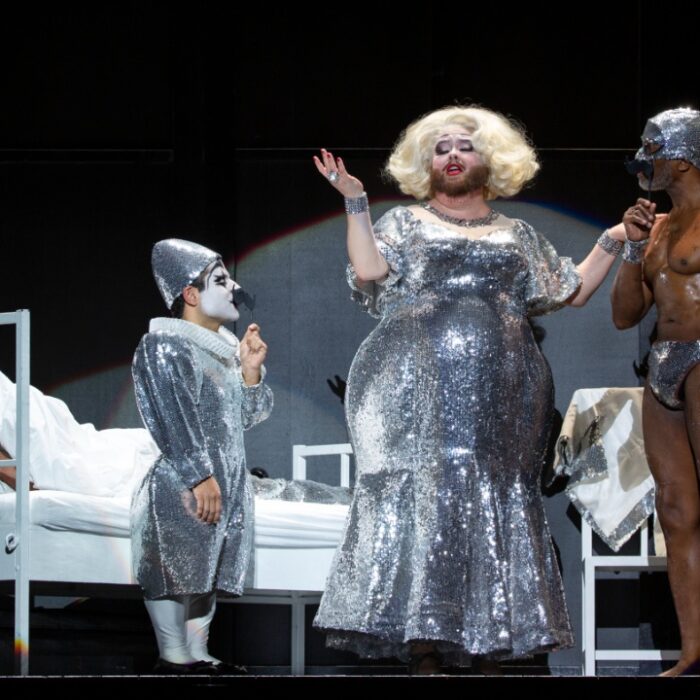
San Francisco Opera 2022-23 Review: El Último Sueño di Frida y Diego
Daniela Mack Shines in a Visually Stunning Production Lacking in Depth
By Lois Silverstein(Credit: Cory Weaver / San Francisco Opera)
On June 19th, up and down Market Street in San Francisco, rainbows ruled the scene, as did live and recorded music. Every variation – hats, masks, sweaters, shoes, leggings, and floral wreaths braided the streets as the Gay Pride Parade intersected with the first-ever Spanish language opera to be performed by San Francisco Opera. “El Última Sueño di Frida y Diego,” created by composer Gabriela Frank and librettist Nilo Cruz, was performed as the company’s finale to their Summer Season. It was a veritable carnival of sound, music, and “son et lumber,” following Richard Strauss’s “Frosch” and Puccini’s “Butterfly.” Visually, it was stunning.
The opera had its world premiere with San Diego Opera in October 2022. San Francisco’s production is the original production by Mexican director Lorena Maza. The creative team of set designer Jorge Ballina, costume designer Eloise Kazan, and lighting designer Victor Zapatero provided their exquisite skills to the extraordinary production. Further, Detroit Opera Music Director Roberto Kalb, who led the premiere performances in San Diego, conducts the San Francisco Opera orchestra in debut. San Francisco Opera and San Diego Opera co-commissioned the work.
Lena Frank and Nilo Cruz derived the opera from the life story of Mexican artists Frida Kahlo and Diego Rivera. The opera takes place in 1957 on “El Día de los Muertos” (The Day of the Dead), three years after the death of Frida Kahlo. Rivera yearns to see his beloved Frida again, and his wish comes to fruition on that day when the two artists meet for a brief reunion. It hearkens to the tale of Orpheus/Eurydice tale, brimming with the same love and longing.
Frank has had her music performed by leading national ensembles, including Chicago Symphony, Boston Symphony, Cleveland Orchestra, San Francisco Symphony, and the Philadelphia Orchestra, where she served as Composer-in-Residence. “El Último Sueño di Frida y Diego” is her first opera. Nilo Cruz, winner of the 2003 Pulitzer Prize for Drama for his play “Anna in the Tropics,” was the opera’s librettist.
Sights & Sounds Abound
Underscoring the pictorial aesthetic of the production, the designers enclosed the entire stage in a gold frame. Stunning design, brilliant color, and technical wizardry made the performance a feast for the eyes. From beginning to end, the focus was on the unique vision of the creators, and the audience sat in awe. We could not help but think of early opera and its “machines” in court performances. The beauty/color, proportions, and balance were on par with the skill displayed. Each of the two acts created fine marvels: the scene in the church, with its multiple rows of pews and the array of congregants in various postures of mourning; the rising and falling of the projections; the scene in Diego’s studio, and with the long strip of blank canvas waiting for the magic brush of the Mexican master. It never arrived, and the canvas became a scrim behind which the dead Frida appeared. The finale has the inset frame turning artists back from “real” persons into icons in a portrait. It couldn’t have been more ingenious. The fashioning of the color palette contributed more than trendy enjoyment. The costumes were beautiful. Oranges and russet colors, punctuated by rose, yellow, and ochre hues, made the whole milieu a living archetype of the harvest of life.
While an array of instruments and the juxtaposition of these instruments bound the score together, incorporating sixty instruments, including percussion, celesta, harp, and an array of strings, it served as a powerful accompaniment to the narrative, surpassing its own role as a strong actor in the story. With the downbeat being the sounding of a broad cymbal and the subsequent choral appearance, it seemed Puccini’s “Turandot” had begun. Indeed, not a bad way to introduce a town’s response to its cultural center. Of course, it moved in its own cultural ambiance. Woven together and unfolded, the studied icons guided the events rather than a lyrical pulse. Vibrant sounds rose and fell all along, but they missed musical urgency or crescendo. That was disappointing.
Admirable Performances
The principal singers brought more fire as the next scenes unfolded. Argentine mezzo-soprano Daniela Mack sang the role of Frida Kahlo. Mack, a former Merola Opera Program participant and San Francisco Opera Adler Fellow made her company debut as Lucienne in Korngold’s “Die Tote Stadt” in 2008, followed by appearing as Idamante in Mozart’s “Idomeneo.” There too, she was highly praised for her strong legato and powerful expressive palette. In her role as Frida Kahlo, she conveyed some of her intensity and power. Notable was the dramatization of her push/pull, touch/no touch gestures with Diego. This was partly because of the admonition she had to obey: on the day she could return, she could not touch a living being.
Mexican baritone Alfredo Daza, also a former Adler Fellow at the San Francisco Opera (1998), created the role of Diego Rivera. Through thick and dense physical presentation, he conveyed a depth of gloom and depression that characterized the painter, who seemed to depend on his beloved for her color and warmth to come alive. Sometimes, this style echoed the dark beauty of his longing, giving a glum heaviness, and it was most effective.
Chilean soprano, Yaritza Véliz, made her house debut as Catrina, the Keeper of the Dead. She sang with compelling feeling and dramatic fervor. Her skeletal-designed costume and dramatic makeup intensified her vocal presence. Death was never far from the audience as she made her way on stage. We dared not forget this sharp and telling focus.
American countertenor, Jake Ingbar, sang the role of the young actor Leonardo, who briefly returned to the world of the living in the guise of actress Greta Garbo. His acting and singing provided a welcome contrast to the other, more molten, figures. The operatic twist of a male countertenor stroking the air as a woman in a stunning outfit added another color to the continuing thread of sexuality that pervaded each act.
Other cast members included Mikayla Sager, Gabrielle Beteag, Nikola Printz, Moisés Salazar, and Ricardo Lugo. Chorus Director John Keene prepared the artists of the San Francisco Opera Chorus, with choreography by Colm Seery.
Visuals Dominate While Depth Lacks
What we learned about Kahlo and Rivera focused more on some of the biographical details, such as the artists living in San Francisco from 1930 to 31 on Montgomery Street. We learned Rivera painted significant murals during this time, and Kahlo painted several of her own important works. With their return in 1940, Rivera painted the Pan American mural on Treasure Island, Kahlo sought medical treatment, and they remarried in City Hall, directly opposite the opera house. All this was most fascinating for sure, but it added little to the story of their art and its significance, which did not come alive in depth. We learned little about the artists or the nature of their art. What about their artistic credos, their artistic struggles, and their passionate antagonisms? We saw strong iconic images, attractive and seductive, but the emphasis was on their display rather than deep exploration.
Costumed audience members coming to see the story unfold were in their element, but did we know the painters any better as a result? Apart from their soul-wrenching passion for each other, movingly demonstrated in Kahlo’s return from the dead (though her return is premised on the prohibition of even touching him), we felt the reverberations of their feelings, but not the feelings themselves.
For sure, they lost something profound, but what? What did they want from each other? What had they learned from each other? What bonded and divided them? That level of dialogue remained absent. Perhaps it could be found in the dramatic interchange or the text. Compare the longing and despair of Don Carlo and his “mother” in Verdi’s complex “Don Carlo.” The confusion kept us enraptured but also held us on the surface. Our dominant technological culture presses us to look/see rather than think/feel. We “know” how to watch and listen extremely well. It is a shorthand. We become satisfied with the summary as if it were an in-depth tale. From the moment we saw an audience member sporting a Frida Kahlo coat while making her way to her seat, we knew the scene on stage was mere display—skillful and very beautiful for sure, but little more.
The dominant emphasis on the visual production pushed the choral efforts into the background as well, even though they were essential to the unfolding of the tale. The “crowd” scenes gave amplitude to the community aspect of the story. They were essential, but musically, their skill was subordinated to the visual effect.
All in all, it was a gorgeous production and an essential contribution to opera literature and to San Francisco’s repertoire, yet musically and emotionally, the opera was a limited affair.


